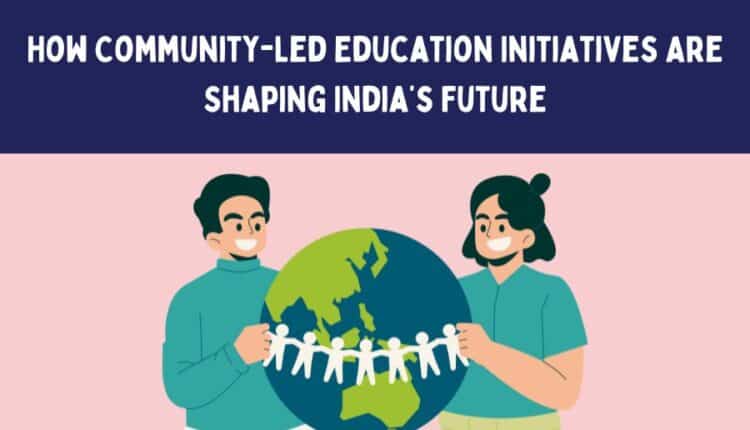How Community-Led Education Initiatives Are Shaping India’s Future
Education is a powerful tool that can transform lives, break the cycle of poverty, and empower entire communities. Across India, especially in underprivileged regions, access to quality education is still a significant challenge. While government policies and national schemes contribute to educational reform, local community-led initiatives are making a profound difference at the grassroots level.
This article explores how grassroots and community-driven education initiatives are shaping India’s educational landscape, especially for marginalized groups, including girls and economically weaker sections.
The Growing Role of Local Educational Movements
Over the past decade, India has seen a rise in non-governmental organizations (NGOs), community collectives, and volunteer-based learning centers. These initiatives often emerge in response to the lack of quality schooling in low-income areas or tribal belts.
They focus not just on academics, but on holistic development, which includes emotional well-being, life skills, digital literacy, and vocational training. Such approaches aim to prepare children and young adults for real-world challenges.
What Makes Community-Led Models Effective?
Community-based education initiatives are rooted in local needs and culture. Unlike a one-size-fits-all approach, these models are flexible, participatory, and responsive. Here’s why they work:
- Local Participation: Involvement of parents, teachers, and community elders builds trust.
- Tailored Curriculum: Programs often incorporate region-specific needs like agricultural literacy, gender sensitivity, or tribal dialects.
- Mentorship & Guidance: Volunteer teachers and professionals guide children beyond textbooks.
- Continued Support: Follow-up mechanisms ensure sustained learning through home visits and after-school sessions.
Impact Through Real Stories: From Slums to Schools
Let’s consider a small settlement near the Yamuna Bank in Delhi. Several families live here without access to formal education. A small group of young professionals, moved by the disparity, started evening classes under a makeshift tent. What began with just 5 children has now grown into a full-fledged learning center.
These local heroes have since partnered with a free education NGO in Delhi NCR, providing books, uniforms, and digital learning tools. The children, once caught in the cycle of labor and illiteracy, now dream of becoming teachers, doctors, and artists. This transformation showcases the deep impact of locally-led interventions.
Bridging Gaps with Technology and Innovation
Technology has further enabled community-led education models to scale. Even in semi-urban and rural regions, smartphones and basic internet connectivity have empowered NGOs to introduce:
- Digital Classrooms
- Recorded Video Lectures
- Mobile App-Based Learning
- Virtual Career Counseling
This tech-enabled learning helps reach children who otherwise couldn’t attend physical classes due to work, distance, or gender-based restrictions.
Why Localized Education Is Vital for Girls’ Empowerment
One of the most critical aspects of community-led efforts is the focus on gender equality in education. In many traditional households, educating girls is still not a priority. But ground-level organizations are changing that.
Through door-to-door awareness campaigns, women-led tutoring centers, and safe, girl-friendly classrooms, these efforts are making education more accessible for girls.
A rural initiative in Uttar Pradesh, for instance, began a weekend learning program where mothers were also encouraged to participate. The ripple effect? Girls who once dropped out due to domestic chores rejoined and even inspired their siblings. This is a small but important example of how education for girls in India can be achieved when communities take charge.
Comparing Traditional vs Community-Driven Models
Here’s a table comparing government school systems and grassroots education efforts:
| Feature | Government Schools | Community-Based Initiatives |
|---|---|---|
| Curriculum | Fixed, centralised | Adaptive, localised |
| Teacher-Student Ratio | Often high | Low for personalized attention |
| Infrastructure | Often lacking | Innovative makeshift or shared spaces |
| Engagement | Limited parent involvement | Active community participation |
| Gender Sensitivity | Generic approach | Specific campaigns for girls’ education |
Challenges These Initiatives Face
While the impact is undeniable, community-led education initiatives face several roadblocks:
- Limited Funding: Many are volunteer-run and depend on donations.
- Recognition: Lack of formal accreditation can limit student prospects.
- Scalability: Custom models are hard to replicate on a larger scale.
- Burnout: Volunteers often juggle jobs and teaching without institutional support.
Government-NGO Partnerships: A Way Forward
Several state governments are beginning to recognize the importance of local NGOs and community-based schooling. By offering grants, resources, and collaborative platforms, the public sector can amplify the impact of grassroots education movements.
Public-private partnerships (PPP) can be instrumental in providing scale, structure, and sustainability to these otherwise fragmented efforts.
How You Can Support Community-Based Education
You don’t have to be an educator to contribute. Here are ways you can support:
- Volunteer your time: Teach online or in-person once a week.
- Donate resources: Stationery, books, and refurbished laptops go a long way.
- Mentor a student: Guide a student through their learning journey.
- Partner with NGOs: If you run a business, consider CSR partnerships with local education groups.
Notable Organizations Making a Difference
Here are a few known names contributing to community-led education in India:
- Pratham Education Foundation – Works across rural India for foundational literacy.
- Teach For India – Places fellows in under-resourced schools across metro cities.
- Barefoot College – Empowers rural communities, especially women, through education and vocational training.
- Deepalaya – A pioneer in community-based education in urban slums.
Final Thoughts
Community-led education initiatives are not just patchwork solutions. They are a vision for what inclusive, empathetic, and effective education can look like. While formal schooling systems will always be necessary, the human touch, responsiveness, and cultural alignment of local models make them indispensable.
They bring learning to the doorstep of those forgotten by mainstream systems. They ignite curiosity where there was once despair. Most importantly, they prove that education isn’t just a right—it’s a shared responsibility.


